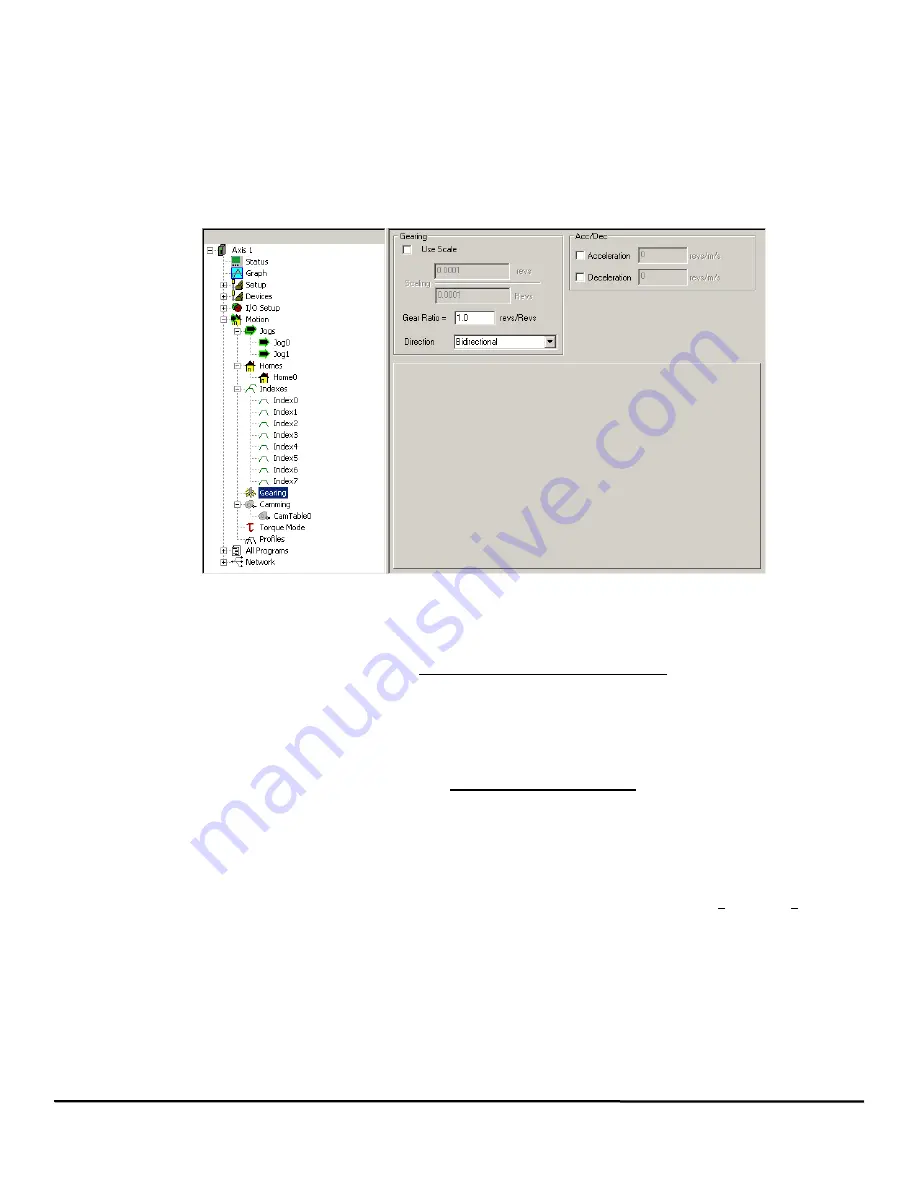
98
Epsilon EP-P Drive Reference Manual
www.controltechniques.com
Revision: A4
Right Click Method
Adding an Index
Navigate to the Indexes View. Position the mouse pointer in the right side of the view and right-click the mouse. A selection box will appear
allowing the user to add a New Index or Delete an Index. Click on New Index and an index will be added in sequential order and that Index’s
setup view will open allowing the user to enter the index parameters.
Deleting an Index
Navigate to the Indexes View. Select the Index you wish to delete, and then right-click the mouse. A selection box will appear allowing the user
to add a New Index or Delete an Index. Click on Delete Index and the selected index will be deleted from the configuration.
3.37
Gearing View
Figure 110:
Gearing View
3.37.1 Use Scale Check Box
Select this check box (Gear.UseScaleEnable) to enable the Scaling feature and disable Gear Ratio. Scaling allows the user to use irrational
ratios such as 1.0/7.0 that were not possible with the single parameter ratio (Gear.Ratio). Scaling is defined as follows:
3.37.2 Gear Ratio
Gearing is used to fix the motion of the motor to the motion of the master axis signal at a specified ratio. This is commonly called “electronic
line shafting” or “electronic gearing”. To gear the motor to the master axis, a ratio must be specified as a relationship between follower distance
units and master distance units. The ratio is as follows:
The ratio (Gear.Ratio) is defined as the number of follower distance units to move the motor per master distance unit of travel. The master
distance units are configured on the Master Units view. The gear ratio can be positive or negative and is a signed 32-bit parameter. The
resolution of the parameter is determined by the number of decimal places configured for the Master Velocity Units on the Master Units view
By default, gearing does not use acceleration or deceleration ramps with respect to the master encoder. This means that once gearing is
activated, peak torque is available to try to achieve the specified gear ratio. Therefore, if the master axis is already in motion when gearing is
activated, the control loop will attempt to accelerate the motor to the programmed ratio within one update (800µsec < update rate <1600 µsec).
Analogously, when gearing is deactivated, the motor will use peak torque to bring the motor to a stop without a deceleration ramp.
3.37.3 Direction
Direction allows the user to select which master axis command the follower is going to follow and the choices are Bidirectional, ComMinus and
ComPlus.
Bidirectional
The follower will follow both the plus and minus master axis command.
ComMinus
The follower will follow only the minus master axis command.
ComPlus
Scaling =
Gear.ScaleNumerator (User Units)
Gear.ScaleDenominator (Master Units)
Gear Ratio =
# of Follower Distance Units
1 Master Distance Unit
Summary of Contents for Epsilon EP-P
Page 2: ......
Page 124: ...110 Epsilon EP P Drive Reference Manual www controltechniques com Revision A4...
Page 200: ...186 Epsilon EP P Drive Reference Manual www controltechniques com Revision A4...
Page 218: ...204 Epsilon EP P Drive Reference Manual www controltechniques com Revision A4...
Page 238: ...224 Epsilon EP P Drive Reference Manual www controltechniques com Revision A4...
Page 244: ...230 Epsilon EP P Drive Reference Manual www controltechniques com Revision A4...
Page 247: ......
















































